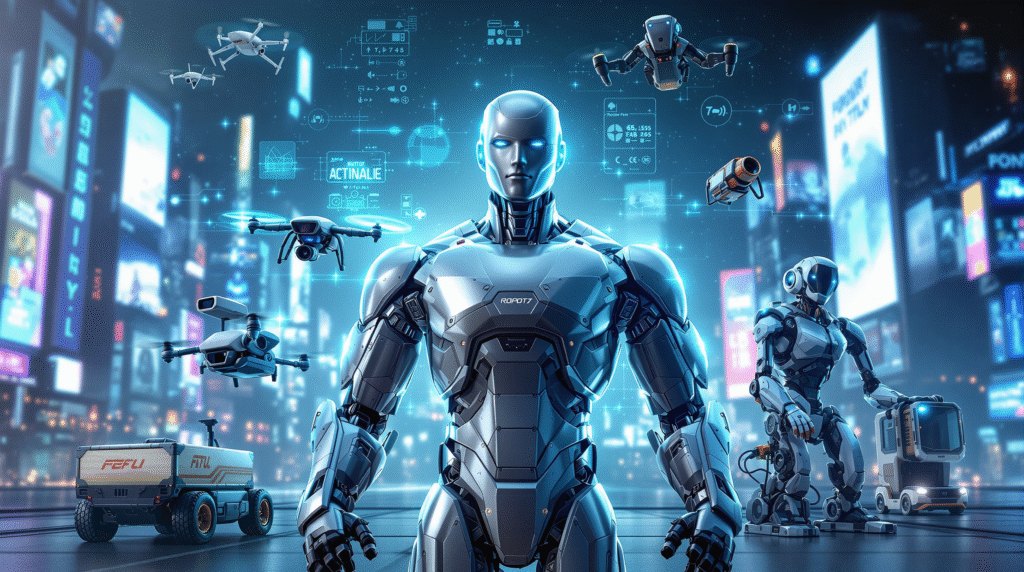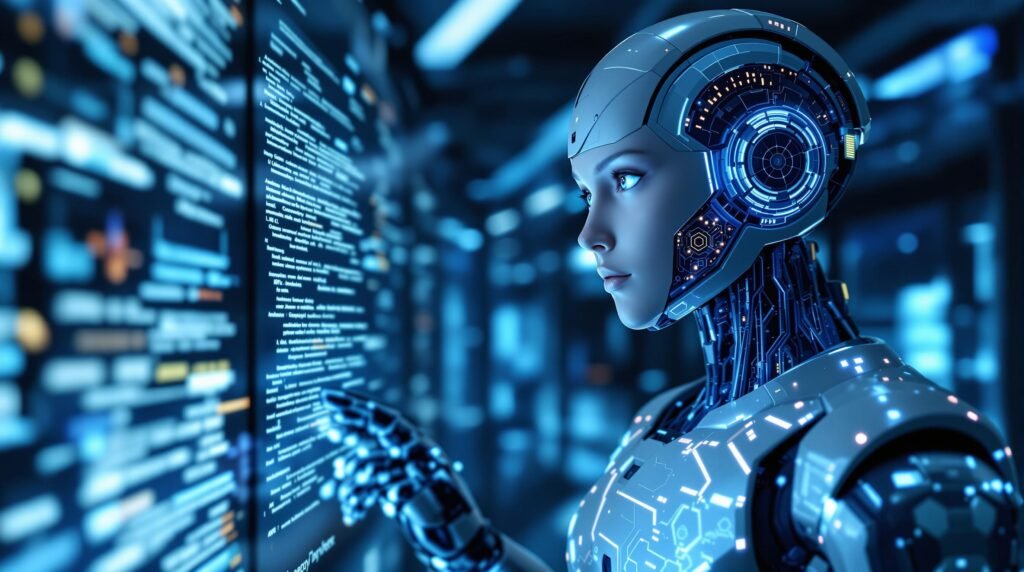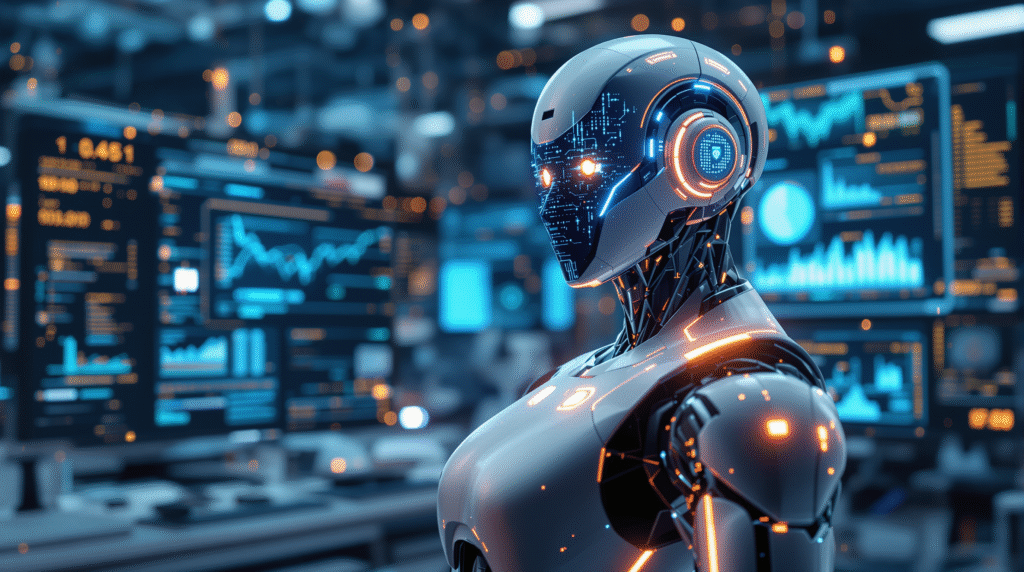Introduction: The Diversity of AI Agents in Modern Technology
AI agents are programs or systems that can independently make decisions and perform tasks based on data from their environment. Modern artificial intelligence uses various types of agents that differ in complexity, scope, and decision-making methods. This makes it possible to create solutions tailored to specific needs—from simple automatons to advanced learning systems.
Understanding the types of AI agents allows for better technology selection for a given application, process optimization, and increased implementation efficiency. In the following sections, we will look at the most important types of agents, their features, and practical examples.
Reactive Agents: Simple Responses to Immediate Stimuli
Reactive agents are the simplest type of AI agents. Their operation is based solely on current stimuli from the environment—they have no memory of past events and do not analyze the history of their actions. They make decisions immediately, reacting to what is happening here and now.
Features of reactive agents:
Lack of memory—they do not store information about previous states or actions.
Speed of reaction—they respond immediately to changes in the environment.
Simple logic—they operate according to established „if-then” rules.
Examples of applications:
A simple vacuum cleaning robot that changes direction after encountering an obstacle.
Alarm systems that trigger a signal upon detecting motion.
Automatic street lights that turn on when a vehicle is detected.
Reactive agents work well where a quick response to changing conditions is important and long-term analysis is not required. They are the basis of many simple automations in the home, industry, or transportation.
Model-Based Reflex Agents: Using Internal Models for Decision-Making
Model-based reflex agents are a more advanced version of reactive agents. In addition to reacting to current stimuli, they have an internal model of the world that allows them to predict the effects of their actions and better understand the environment. This allows them to make more accurate decisions, even in situations where not all information is directly available.
Features of model-based reflex agents:
Having an internal representation of the environment (world model).
Ability to predict the consequences of one’s own actions.
Better adaptation to changing conditions and incomplete data.
Examples of applications:
Warehouse robots that plan their route, taking into account obstacles and changes in the environment.
GPS navigation systems that predict traffic jams and suggest alternative routes.
Smart thermostats that learn the habits of household members and predict the need for heating.
Model-based reflex agents are used where it is necessary to predict and plan actions in a dynamic environment.
Goal-Based Agents: Striving to Achieve Specific Objectives
Goal-based agents represent another level of advancement. In addition to a model of the world, they have clearly defined goals that they strive to achieve. They can analyze various possible scenarios and choose the actions that bring them closest to achieving the intended result.
Features of goal-based agents:
Defining and achieving goals.
Ability to plan sequences of actions leading to the goal.
Flexibility in choosing a strategy depending on the situation.
Examples of applications:
Autonomous vehicles that plan a route to reach their destination as quickly and safely as possible.
Virtual assistants that help the user accomplish tasks, such as planning a day or booking a ticket.
Industrial robots that optimize the sequence of operations to increase production efficiency.
Goal-based agents are essential where not only reaction to stimuli is important, but also long-term planning and the implementation of complex tasks.
Utility-Based Agents: Optimizing for the Best Possible Outcome
Utility-based agents are advanced systems that not only strive to achieve a goal but also evaluate different possible scenarios in terms of their „utility”—that is, how beneficial a given outcome is for the agent. Thanks to this, they can choose not only actions that lead to the goal but also those that maximize benefits or minimize losses.
Features of utility-based agents:
Having a utility function that allows them to assess the value of different states or outcomes.
The ability to compare and select the best possible options.
The capacity to make decisions in situations of uncertainty or conflicting goals.
Examples of applications:
Recommendation systems that suggest products or content to maximize user satisfaction.
Automated trading algorithms that select transactions with the highest profit potential.
Advanced energy management systems that optimize electricity consumption in buildings.
Utility-based agents are especially useful where there are many possible solutions and it is necessary to choose the most profitable or safest one.
Learning Agents: Adapting and Improving Based on Experience
Learning agents are the most flexible and autonomous types of AI agents. They can analyze their actions, draw conclusions from successes and failures, and modify their strategies based on acquired experience. As a result, they become more effective and better adapted to changing conditions over time.
Features of learning agents:
The ability to learn independently from data and interactions with the environment.
The possibility to modify their own rules of operation and strategies.
Continuous adaptation to new situations and challenges.
Examples of applications:
Speech and image recognition systems that improve their effectiveness as they process more examples.
Autonomous vehicles that learn from thousands of hours of driving in various conditions.
Chess or Go programs that independently refine their strategies by playing against other agents or humans.
Learning agents are crucial in dynamic environments where conditions often change, and previous experiences can significantly improve performance.
Hierarchical Agents: Organizing Complexity Through Layers of Control
Hierarchical agents are systems that organize their actions into a layered structure. Each layer is responsible for a different level of detail or task complexity—from general planning to detailed execution. Thanks to this, the agent can effectively manage complex processes by breaking them down into smaller, more manageable stages.
Features of hierarchical agents:
Division of tasks into layers, e.g., strategic, tactical, and operational planning.
The ability to delegate tasks between layers—higher layers set goals, lower layers carry out specific actions.
Better scalability and easier management of complex systems.
Examples of applications:
Industrial robots, where one layer plans the sequence of operations and another controls the movement of the robot arm.
Urban traffic management systems, where a higher level plans the overall strategy and a lower level controls traffic lights at individual intersections.
Autonomous vehicles that combine route planning (higher layer) with real-time driving control (lower layer).
Hierarchical agents are essential where tasks are complex and need to be divided into smaller, cooperating modules.
Multi-Agent Systems: Collaboration and Competition Among AI Agents
Multi-agent systems are environments in which many AI agents operate, either cooperating or competing with each other. Each agent can have its own goals, strategies, and resources, and their interactions lead to the emergence of complex behaviors at the system level.
Features of multi-agent systems:
Cooperation—agents can share information, coordinate actions, and jointly accomplish tasks.
Competition—agents may compete for resources or pursue conflicting goals.
Decentralization—there is no single central control; decisions are made locally by individual agents.
Examples of applications:
Smart energy grids, where agents manage energy production and consumption at different points in the network.
Video games, where AI-controlled characters cooperate or compete with the player and with each other.
Logistics systems, where agents manage vehicle movement, warehousing, and deliveries.
Multi-agent systems make it possible to solve problems that are too complex for a single agent and to model complex interactions in real-world environments.
Hybrid Agents: Combining Different Approaches for Better Results
Hybrid agents are systems that combine features of various types of AI agents to achieve greater flexibility and effectiveness. They can use both simple reactive rules and advanced machine learning models, goal planning, or utility evaluation. Thanks to this, they are better able to cope in complex, dynamic environments where a single approach might be insufficient.
Features of hybrid agents:
Integration of different action strategies (reactivity, planning, learning, optimization).
The ability to switch between modes depending on the situation.
Increased resilience to unforeseen events and better adaptation to changes.
Examples of applications:
Modern autonomous vehicles that combine quick reactions to hazards with long-term route planning and learning from experience.
Advanced production management systems that automatically adjust processes to changing market and operational conditions.
Virtual assistants that can both conduct conversations and analyze data, plan tasks, or learn user preferences.
Hybrid agents are increasingly used in practice because they allow for the creation of more universal and reliable solutions.
Conclusion: How to Choose the Right Type of Agent for Your Application
The choice of the right type of AI agent depends on the specifics of the task, the environment, and user expectations. Simple reactive agents are suitable where quick response and simplicity are important, while learning or hybrid agents are a better choice in dynamic, complex systems that require adaptation and optimization.
It is worth analyzing what goals the agent is to achieve, what data will be available, and how variable the environment is. Often, the best solution turns out to be a combination of several approaches—for example, a hybrid agent that combines quick reactions with the ability to learn and plan.
Understanding the differences between types of AI agents allows you to better match the technology to your needs and implement modern solutions more effectively in practice.
Building AI Agents: A Practical Approach to Python
Building AI Applications: A Guide for Modern Developers
The AI Agent Revolution: Changing the Way We Develop Software


